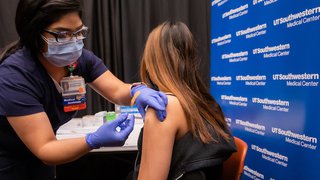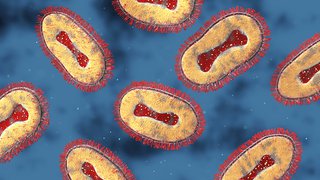Back to school during COVID-19: Safety advice from 3 doctors
August 7, 2020

Parenthood is a nonstop exercise in risk management. From swimming to gaming to biking, all our kids' activities bear some risk to their physical and emotional health. Returning to school during an unpredictable global pandemic is our next collective parenting challenge.
Unfortunately, there’s no one-size-fits-all solution to the COVID-19 school dilemma.
Longstanding research shows that children benefit from in-person learning in a multitude of ways. Aside from getting a strong education and daily structure, interacting with friends and teachers helps many children shape their identity and strengthen their mental health. For some students, school is a refuge from food insecurity or safety concerns at home.
The American Academy of Pediatrics (AAP) has also suggested there is evidence that school closures and the shift to online learning earlier this year have had a negative impact on child development.
At the same time, we must recognize the very real health concerns and economic ramifications of reopening schools right now. In an area such as North Texas, COVID-19 cases, hospitalizations, and deaths continue to progress at a high rate. If our communities are swept up by another spike in infections spread at schools, we'll likely face further shutdowns and even more long-term setbacks for students, parents, teachers, and school staffs.
There is no debate that the novel coronavirus has upended all our lives since March. The ongoing threat of its spread will be with us for the foreseeable future – at least until we have a viable vaccine. That means learning experiences will also be vastly different until then.
As parents, the best you can do is what you've always done: manage your kids' risks. You are their source of security and stability in the churn of this pandemic.
As pediatric specialists at UT Southwestern and Children's Health Dallas, it is our role to offer sound, evidence-based advice that can help you prepare for an unconventional – but safe – return to school in 2020-2021.
In-person vs. online learning: 3 key factors
Depending on where you live – and whether you want your child to learn through the school district – you may have to make the tough choice between in-person or virtual learning.
Some local school districts, such as Fort Worth and Plano, have already announced they will be starting all students on virtual learning, then potentially offering parents the option to switch to in-person learning later. Others will be giving parents online, in-person, or hybrid options. Here are three key things to consider as you make your decision.
1. What is the level of COVID-19 spread in your community?
If you live in an area with a large number of daily new cases and hospitalizations, bringing students back to school in person could increase the level of community spread. Ideally, the World Health Organization recommends a community be below the 5% test-positive level for at least 14 days before reopening. Texas is at about 13%. View updated state-level Texas COVID-19 data.
In North Texas, the positivity rate of all people tested has been about 15% in Tarrant County and 22% in Dallas County.
In July, more than 1,800 Dallas County children were diagnosed with COVID-19, with 38 requiring hospitalization. While children tend not to get as sick as adults with COVID-19, a study published recently in JAMA Pediatrics suggests children can harbor high amounts of the virus in their noses and throats as compared to adults and may be a significant source of spread of the virus, even if they experience mild symptoms.
In addition, a recent study from the University of Texas in Austin estimated the potential risk in each county in the U.S. if school started in person now. In Tarrant County, schools with 500 people could expect four infected students to arrive in the first week, the study said. In Dallas County, it would be five. Search by county.
Takeaway for parents
It’s inevitable that an infected individual will enter your child’s school, likely without knowing they have the virus. That’s why you should review your school’s safety and isolation protocols to understand how it will handle the situation and minimize the risk of spread.
2. Does your child have underlying health conditions?
Children with certain medical conditions such as asthma, cystic fibrosis, immunodeficiencies, or cancer face increased risk for complications from COVID-19. Certain medications affect the body's immunity and can also increase their risk. If your child struggles with depression or anxiety, their symptoms may increase due to pandemic-related stress at school or at home.
Pediatric specialists at UT Southwestern and Children’s Health Dallas have created a guide that categorizes medical conditions by lower, moderate, and high risk for in-person learning. The information is based on a consensus of expert opinions. The guide will be updated regularly based on new data.
Takeaway for parents
Talk with your child's pediatrician and specialist about their physical and mental health. The doctor can help you compare the risks and benefits of virtual learning and in-person school for your family.
3. Is anyone in your household at elevated risk from COVID-19?
"Household" means anywhere your children regularly spend time – their grandparents' homes, another parent's house, or with a sitter. Assess your household risk by determining who at your home faces the most serious complications from COVID-19 infection.
Elderly family members are at increased risk, as are siblings, parents, or grandparents with chronic conditions or who take immune-compromising medications. Chronic conditions of note for adults include diabetes, high blood pressure, asthma, COPD, HIV/AIDS, hepatitis C, obesity, and cancer.
Takeaway for parents
Talk with loved ones who may come in contact with your child about their risks. Your strategy might involve more aggressive physical distancing measures, strict masking rules, or additional hygiene protocols if your child goes to school in person.
In-person school: A checklist for parents
If your child or children are starting the school year in-person, it will be more complicated than ever. The Centers for Disease Control and Prevention (CDC) has created a checklist to help prepare.
We've highlighted some of the important steps to take before, during, and after school. Get our printable checklist.

6 changes kids and parents can expect at school
1. Students will likely stay in 'cohorts'
Grouping students together by classroom so they’ll have limited interaction with other children is one key strategy to reduce spread of the virus. If one child gets sick, the school can isolate their cohort and switch to online learning without closing the entire school.
2. Days will begin with screenings for COVID-19
Your child's school will have a daily COVID-19 screening plan, which may include checking temperatures at home or before entering campus. (Sending a child to school who is feeling a bit under the weather, which we’ve all done, won’t be possible this year.) Schools may also require testing if a child in their cohort gets sick. And there should be a strategy to reintroduce children and staff who either 1) test positive or 2) are exposed to someone who tests positive.
3. Mealtimes will be safer and spaced out
Instead of self-serve from the cafeteria, schools may offer a pre-packaged box meal like you'd get on an airplane. During meals, children will likely have to space out or stick with their cohort. On nice days, eating outdoors might be an option.
4. Some classes may move outside
In Texas, schools could potentially move some classes to outdoor spaces that are covered from the sun. This is recommended for classes that require a lot of interaction (and exhalation), such as choir, speech, or gym.
5. Sports and extracurriculars will be adjusted
Expect new strategies and safety protocols for sports, musical and stage performances, and other extracurricular activities. Some schools may decide to delay team sports or shorten practice and game schedules. Others might cancel entirely – it will largely depend on how the school year goes and whether local infection rates decline.
6. Students can expect stricter hallway and transportation protocols
One-way halls or staggered schedules for excusing students will help avoid large groups in the hallways. Schools may also try rotating teachers among classrooms rather than students. If your child takes a bus to school or is part of a carpool, make sure that face coverings are required.


Virtual learning: A checklist for parents
Transitioning back to school online may be a challenge, particularly if you are working full time and trying to balance the needs of your job and your children.
But patience, flexibility, and open communication can help.
We've highlighted some of the big conversations and preparations you can take to start the year off right. Get the printable checklist.
1. Get to know the assignment and work platform
Each school district is approaching virtual learning differently. Some are using video services to connect students with teachers, while others are implementing educational platforms so students can track their assignments and conduct all their work in one place.
2. Explore support options
While the course material should be similar to the in-person experience, be mindful that your child will need extra support for socializing and peer interaction. Ask your school about virtual opportunities to stay involved with clubs and class activities. Also ask if there will be designated times for online tutoring or one-on-one interaction with your child’s teacher(s).
3. Prepare for technical and personal difficulties
Your child may get frustrated or have trouble concentrating until the new routine sets in. Remain open-minded and reach out to the school if you need support. Expect some delays and technical difficulties on the school’s part, too. You probably experienced this in the spring when most schools shut down and went to remote learning. School administrators, staff, and teachers are adjusting to this new normal as well. Try to keep that in mind, be patient, and embrace the spirit of cooperation we all need now.


Additional resources
The latest from North Texas school districts
Dallas County, Tarrant County, Collin County, Denton County
More back-to-school resources
Guide for parents of children with pre-existing health conditions
A few closing thoughts
Children are, by nature, resilient. They are also familiar with preparing for worst-case scenarios. At school, they regularly participate in drills for fires, tornadoes, or lockdowns. They wear seatbelts and sunscreen, not because they're living in fear, but because you’ve taught them it's smart to do your part in preventing bad things from happening. Don't underestimate their ability to adapt and prepare for unusual situations.
And remember the old adage: Little pitchers have big ears. If you don't agree with the current health recommendations – and you're outspoken in voice or action – your child will get conflicting messages at school and home. To alleviate this stress, discuss your opinions with other adults out of earshot. Modeling responsible behavior is crucial now.
Our best bet as we get ready for the school year – in all its potential forms – is to try to focus on opportunity not obligation. While we have to sacrifice in some areas to get through this pandemic, we get to make the best of a difficult situation.
No single plan will satisfy all our needs. But by working together, acting responsibly, and being quick to adapt, our kids and their teachers can have a safe, fulfilling school year.
To talk with one of our providers or request an appointment about your child's health, please visit Children's Health or UT Southwestern's Department of Pediatrics websites.
For adult mental or physical health appointments, call 214-645-8300 or request an appointment online.













